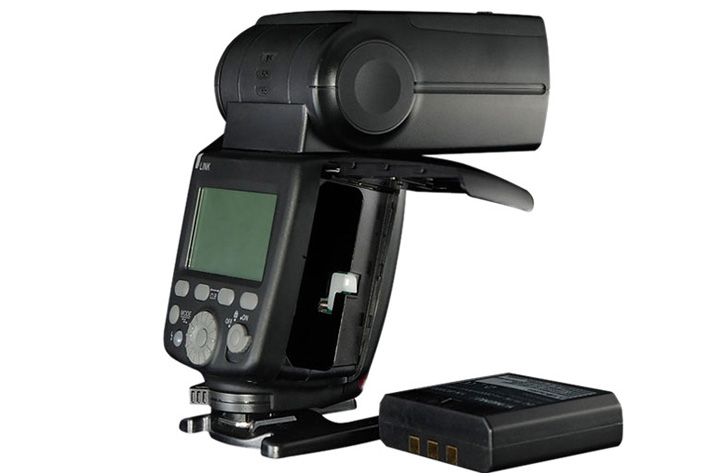
The Yongnuo YN686EX-RT flash is compatible with Canon’s RT- series of flashes, but contrary to Canon’s units uses a lithium-ion battery said to be faster and offer 750 full-power flashes from a single charge.
When lithium batteries became a common thing in the market, some photographers managed to fry their flashes, because they picked a set of AA lithium batteries and used them with the flash. They recycled faster, yes, but were prone to problems, one of them being that they get very hot. They can be used, but if you’re shooting at a fast rate, they will overheat and the flash will shut down, for safety, if it has sensors, or will fry, if not. For “normal” flash shooting, they can be used, but flash makers, apparently, advise against their use.
The manual for Canon’s Speedlite 600EX II-R mentions, under a “Caution” warning, the following: “Do not use ‘AA/R6 lithium batteries’. Note that certain AA/R6 lithium batteries may become extremely hot in rare cases during use. Due to safety reasons, do not use ‘AA/R6 lithium batteries’”. In the specifications for the flash, you’ll find the note stating the type of batteries to be used with the Speedlite: “four AA/LR6 alkaline batteries. AA/HR6 Ni-MH batteries can be used.”
Now, the batteries used by Yongnuo in its flash are completely different, as they are rechargeable lithium-ion, but what’s interesting here is the concept of a dedicated battery, which, according to the information provided by Yongnuo offers 750 full-power flashes from a single charge and improves recycling speed by providing a recycle time of just 1.5 seconds at full power.
The use of a lithium-ion battery is something we’ve not seen in flashes from camera makers, but the example from Yongnuo is not the only one, as Pixel also announced, earlier this year, a X900C for Canon, and a X900N for Nikon, using a lithium-ion battery offering 700 full-power flashes and 1.5 seconds of recycling time after a full power discharge.
As interesting as Yongnuo’s solution may be, the only problem seems to be the YN-B2000 Lithium Battery Pack it uses, which can not be found through a simple search online. Although it is possible to buy the flash with two batteries, it is important to know that the battery pack is available to buy on its own and will continue to be so. I tried to get in touch with Yongnuo to know more about the battery, but got no reply yet. There is no indication of price or availability and without information, it is hard to suggest the flash as a good option.
Technically, the flash seems very promising, with a built-in 2.4 GHz transceiver, letting photographers control and trigger it wirelessly. The important element to retain here is that, according to Yongnuo, the flash is fully compatible with the Canon ST-E3-RT, 600EX-RT II, 430EX III-RT, meaning you can use it with those accessories from Canon, either as master or slave. Or you can opt to use a couple of units of the YN686EX-RT as your system, as the price of one unit is very good: it goes from $140 to $165.00, depending where you buy it.
Compatible with Canon E-TTL / E-TTL II, the YN686EX-RT has another interesting feature: it can work , through optical transmission, as a master or slave for Canon and as a slave for Nikon systems, if ever you need. With a guide number of 60 ISO 100 and 200mm, the flash has a zoom head from 20-200mm, as well a pull-out diffuser for coverage with wide-angles up to 14mm. The head can tilt from -7 to 90° and rotates 180° both to the left and right.
Fully compatible with high-speed and first and second curtain sync functions, the YN686EX-RT is equipped with a USB port, to update firmware, one important element introduced in recent years, allowing to introduce new features or correct problems with the flash. If Yongnuo clarifies the situation regarding the lithium-ion battery pack, if the price is acceptable and it works as promised Yongnuo’s and Pixel’s experiences may well help to define a new trend for speedlites.
